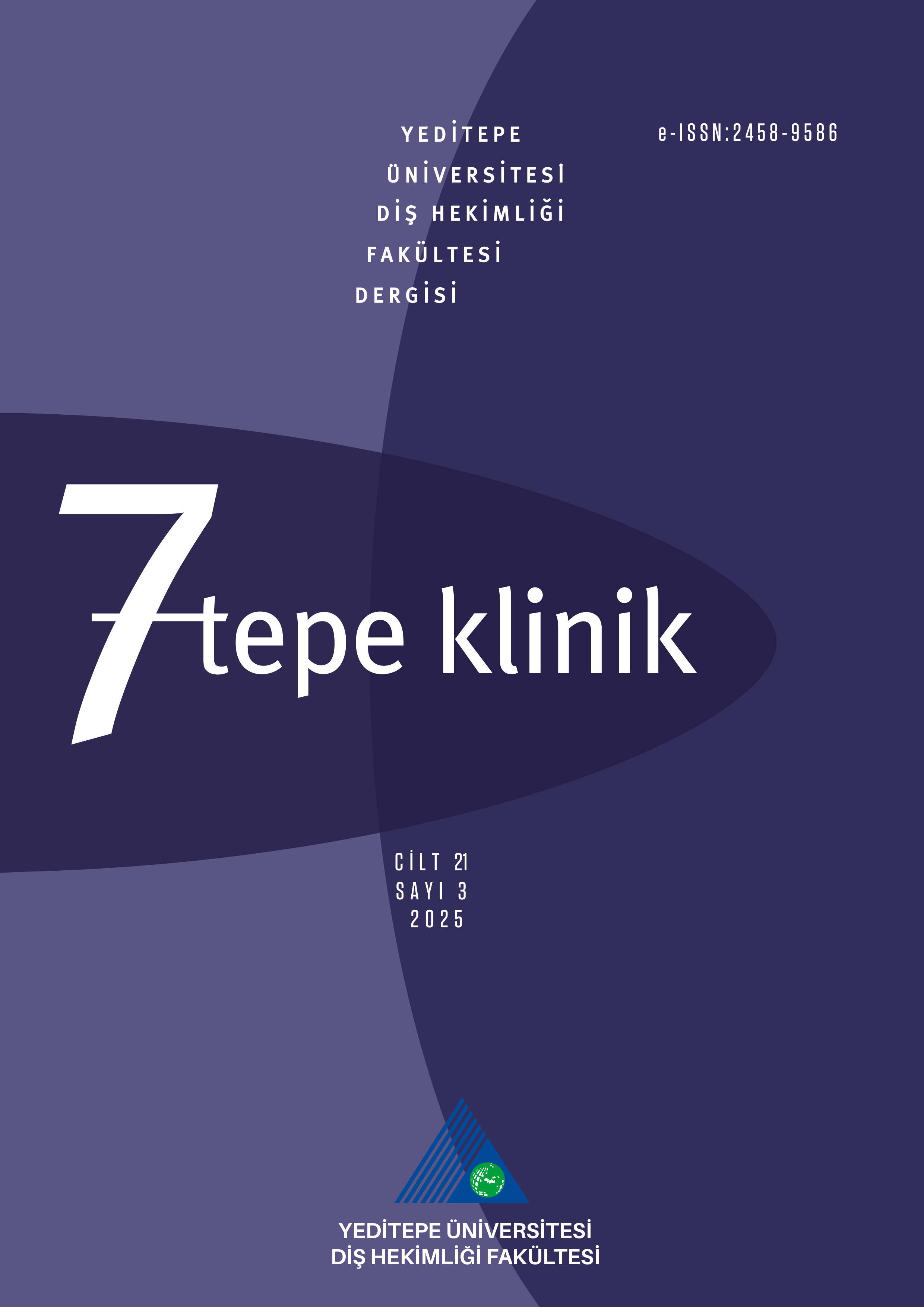Süt dişlerinde demir ilacına bağlı renklenmeler üzerine yüzey örtücü kullanımının etkisi
Emine Kayaİstanbul Okan Üniversitesi, Diş Hekimliği Fakültesi, Pedodonti A.D., İstanbulGİRİŞ ve AMAÇ: Bu çalışmanın amacı, süt dişlerine uygulanan yüzey örtücü ajanların, çocuklarda kullanılan iki farklı formdaki demir şurubunun meydana getirdiği renklenme üzerindeki etkisinin incelenmesidir.
YÖNTEM ve GEREÇLER: Çalışmada toplam 66 adet çürüksüz süt dişi, her bir grupta 11 adet örnek bulunacak şekilde rastgele 6 gruba ayrıldı. Fe+2 (ferröz sülfat) içeren Ferrum Haussman (Vifor International Inc., İsviçre) ve Fe+3 (ferrik polimaltoz) içeren FerroSanol B (UCB Pharma GmbH, Almanya) demir şurubu kullanıldı. Kontrol grubu olarak distile su tercih edildi. Her bir şurup ve kontrol grubundaki örneklerin yarısına yüzey örtücü ajan olarak BisCover LV (Bisco Inc., Itasca, IL, ABD) uygulandı ve diğer yarısına herhangi bir işlem yapılmadı. Her bir diş örneği günde 3 kere 8 saat aralıklarla 2şer dakika bulunduğu gruba göre demir şuruplarına veya distile suya batırıldı. Toplamda 252 daldırma döngüsü uygulandı. Renk değişimleri spektrofotometre (Vita EasyShade Advance 4.0, Ivoclar Vivadent, Liechtenstein) kullanılarak ölçüldü. İki yönlü varyans analizi, renk değişiminin değerlendirilesinde kullanıldı.
BULGULAR: Fe+2 içeren demir şurup grubundaki dişler Fe+3 içeren demir şurubu grubundaki dişlerden daha fazla renk değişimi gösterdi. (p<0,001) Tüm gruplarda yüzey örtücü uygulanan dişlerde uygulanmayan dişlere göre daha fazla renk değişimi görüldü. (p<0,001)
TARTIŞMA ve SONUÇ: Bu invitro çalışmada Fe+2 içeren demir şuruplarının Fe+3 içeren şuruplara göre daha fazla renklenmeye neden olduğu görüldü. Yüzey örtücü ajanlar süt dişlerinde demir ilacına bağlı oluşan renklenmeleri önlemekte etkili değildir.
The effect of surface sealants on discoloration of primary teeth related to iron syrups
Emine Kayaİstanbul Okan Unıversity Faculty Of Dentistry Pediatric Dentistry DepartmentINTRODUCTION: This study aimed to investigate the effect of surface sealant agents applied to primary teeth on discoloration caused by two different forms of iron syrup used in children.
METHODS: In this study, a total of 66 intact primary teeth were randomly divided into 6 groups, with 11 samples in each group. Ferrum Haussman (Vifor International Inc., Switzerland) containing Fe+2 (ferrous sulfate) and Ferro- Sanol B (UCB Pharma GmbH, Germany) containing Fe+3 (ferric polyimaltose) were used. Distilled water was chosen as a control group. BisCover LV (Bisco Inc., Itasca, IL, USA) was applied to the half of the samples as a surface sealant agent and the other half of the samples was not treated. Each tooth sample based on the group type was immersed in iron syrups or distilled water for 2 minutes at 8 hour intervals, 3 times a day. A total of 252 immersion cycles were applied. Color changes were measured by using a spectrophotometer (Vita Easy- Shade Advance 4.0, Ivoclar Vivadent, Liechtenstein). Twoway ANOVA was used to evaluate the effects of color change.
RESULTS: Samples in the Fe+2 syrup group showed more discoloration than the samples in the Fe+3 syrup group. (p <0.001) In iron syrups and control group, the samples with surface sealent exhibited more discoloration than the rest of the samples. (p <0.001)
DISCUSSION AND CONCLUSION: In this in vitro study, it was observed that iron syrups containing Fe+2 caused more discoloration than the iron syrups containing Fe+3. For primary teeth, surface sealants were inefficient on the protection against discoloration caused by iron syrups.
Makale Dili: Türkçe



